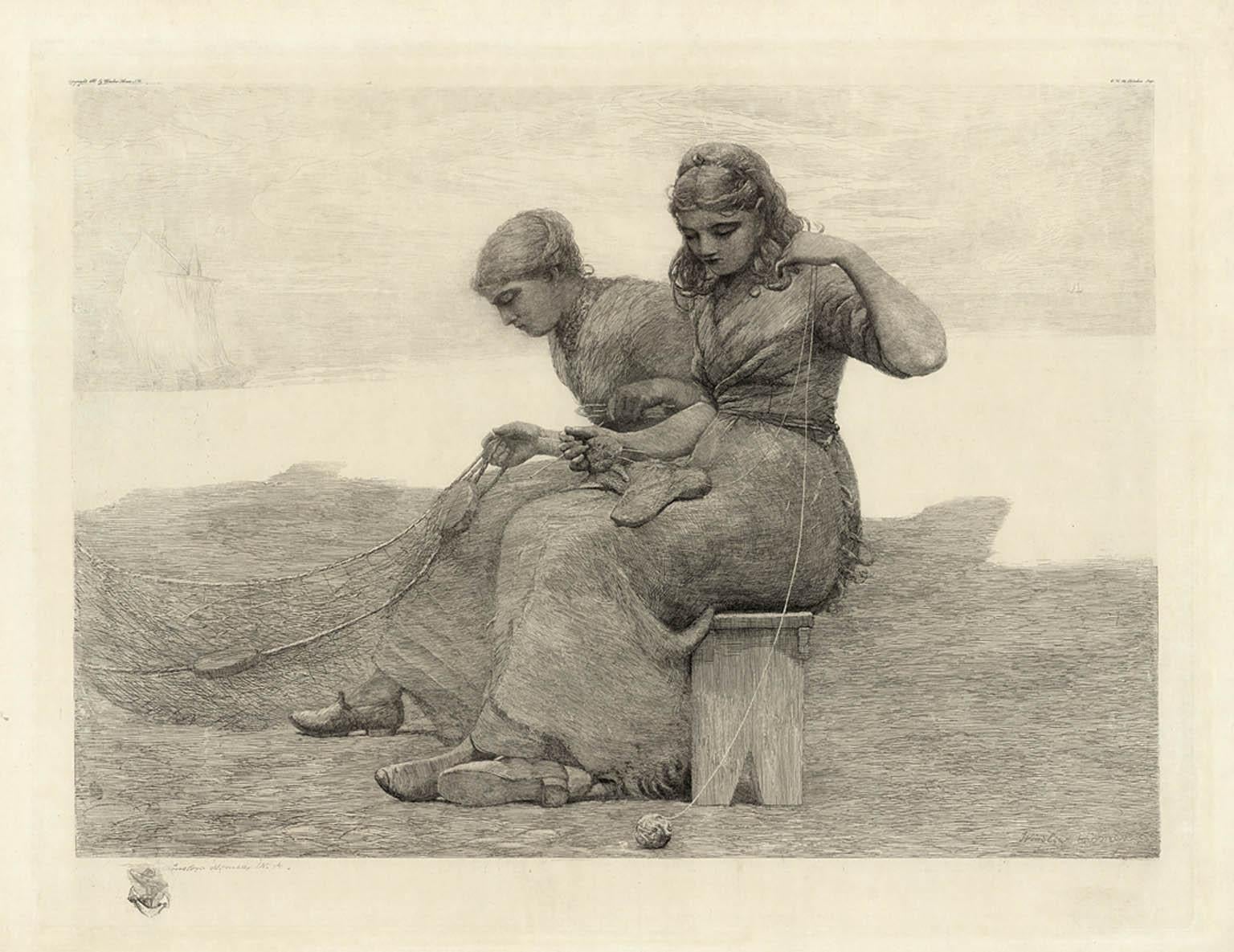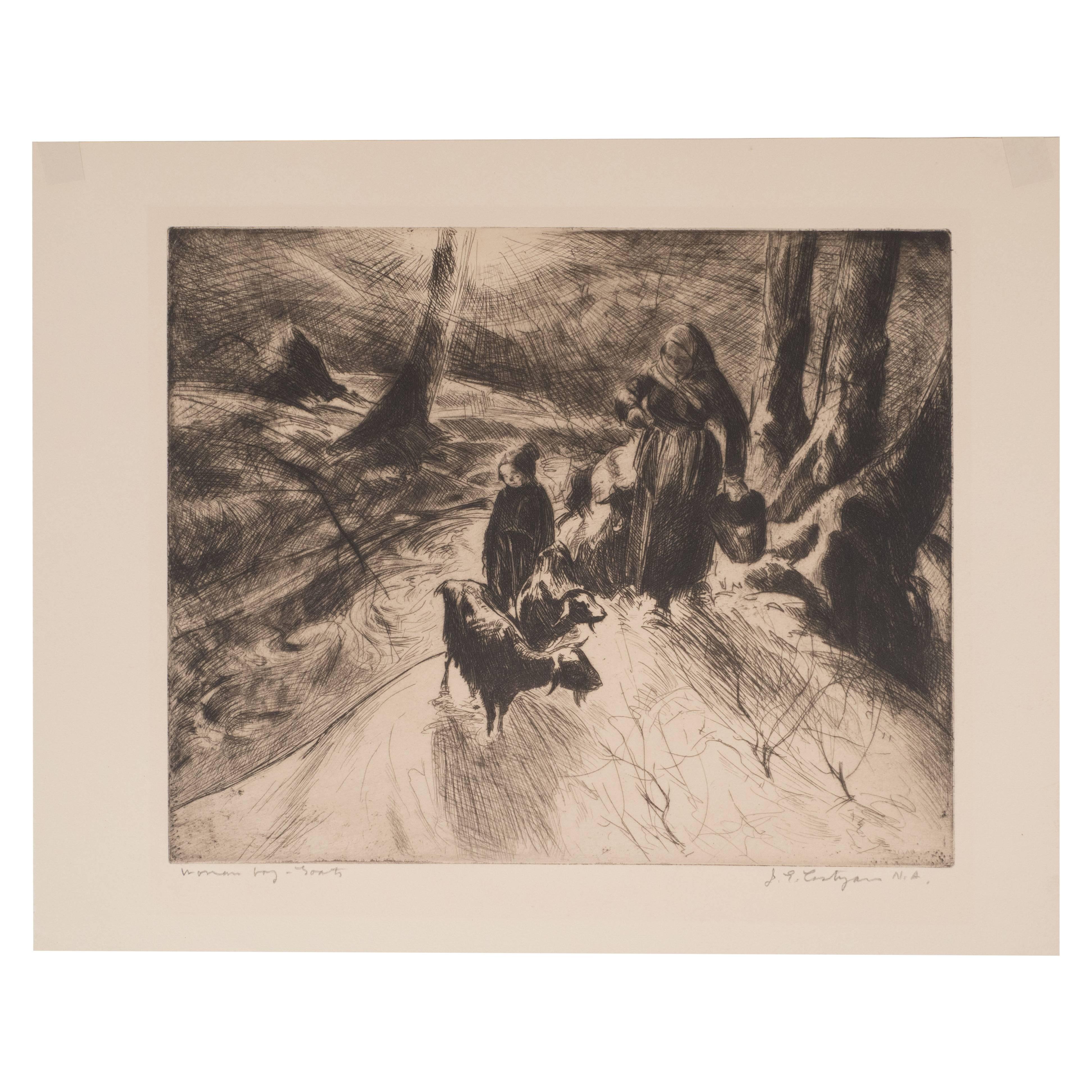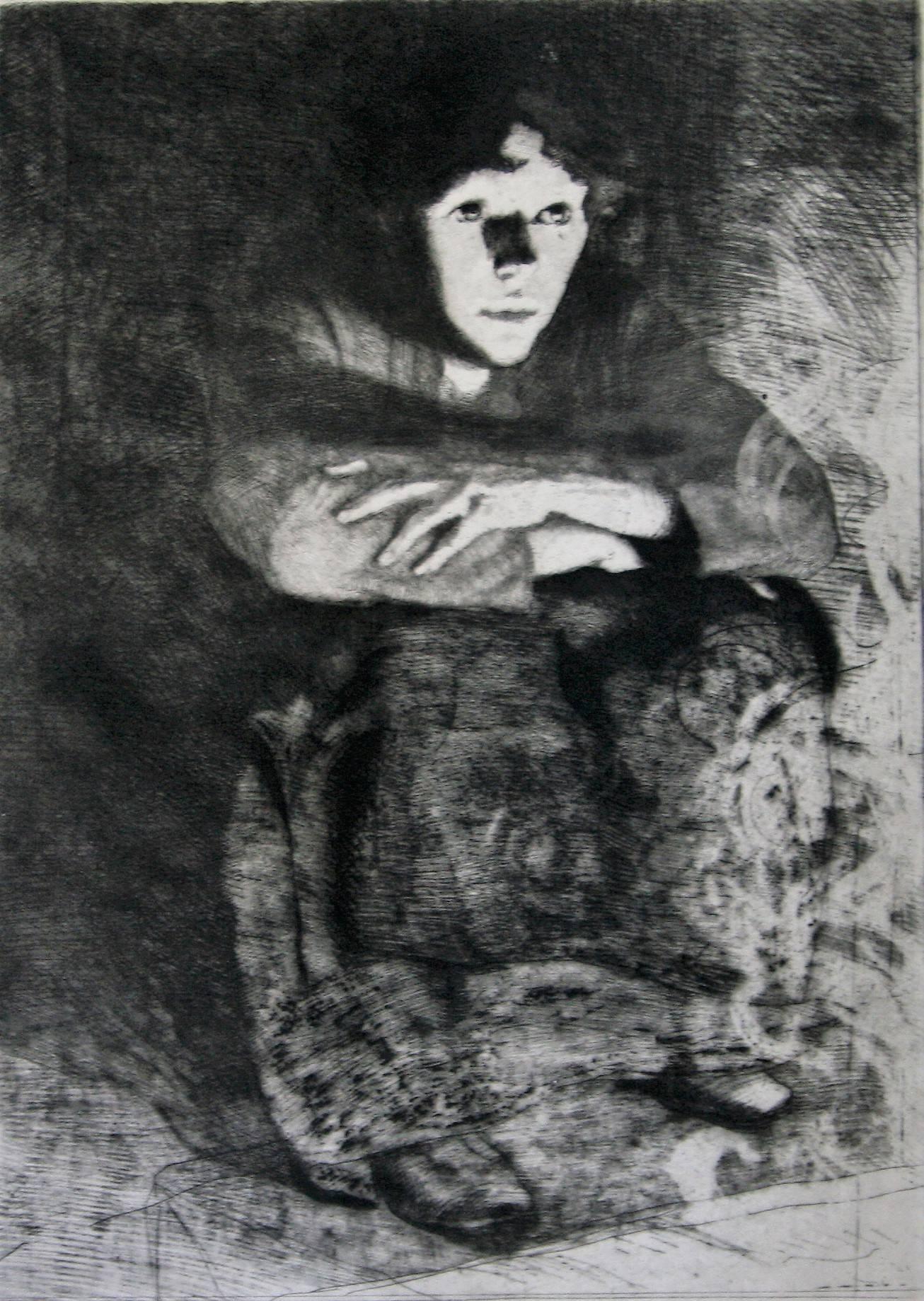Camille PissarroQuai de Paris, à Rouen by Camille Pissarro - Cityscape etching1896
1896
About the Item
- Creator:Camille Pissarro (1831-1903, French)
- Creation Year:1896
- Dimensions:Height: 7.09 in (18 cm)Width: 6.89 in (17.5 cm)
- Medium:
- Movement & Style:
- Period:
- Condition:
- Gallery Location:London, GB
- Reference Number:1stDibs: LU261214154742
Camille Pissarro
Camille Pissarro was one of the most influential members of the French Impressionist movement and the only artist to participate in all eight Impressionist exhibitions.
Born in July of 1830 on the island of Saint Thomas in the Danish West Indies, Camille was the son of Frédéric and Rachel Pissarro. At the age of 12, he went to school in Paris, where he displayed a penchant for drawing. He returned again to Paris in 1855, having convinced his parents to allow him to pursue a career as an artist rather than work in the family import/export business. Camille studied at the Académie Suisse alongside Claude Monet, and, during this time, he met Paul Cézanne, Édouard Manet and Pierre-Auguste Renoir.
In 1869, Camille settled in Louveciennes. The outbreak of the Franco-Prussian War in 1870 prompted him to move to England, and, with Monet, Camille painted a series of landscapes around Norwood and Crystal Palace, while studying English landscape painting in the museums. Upon returning a year later at the end of the War to Louveciennes, Camille discovered that only 40 of his 1,500 paintings — almost 20 years’ work — remained undamaged.
Camille settled in Pontoise in the summer of 1871, remaining there and gathering a close circle of friends around him for the next 10 years. He reestablished relationships with Cézanne, Manet, Monet, Renoir and Edgar Degas, expressing his desire to create an alternative to the Salon, so that their group could display their own unique styles. Camille married Julie Vellay, with whom he would have seven children. Cézanne repeatedly came to stay with them, and, under Camille’s influence, he learned to study nature more patiently, even copying one of Camille’s landscapes in order to learn his teacher’s technique.
The first Impressionist group exhibition, initiated by Monet in 1874, earned the Impressionists much criticism for their art. While mainly interested in landscape, Camille introduced people — generally, peasants going about their rural occupations — and animals into his works, and they often became the focal point of the composition. It was this unsentimental and realistic approach, with the complete absence of any pretense, which seemed to stop his work from finding appreciation in the general public.
One of the few collectors who did show interest in Camille’s work was a bank employee named Paul Gauguin, who, after acquiring a small collection of Impressionist works, turned to Camille for advice on becoming a painter himself. For several years, Gauguin closely followed his mentor, and, although their friendship was fraught with disagreement and misunderstandings, Gauguin still wrote shortly before Camille’s death in 1906: “He was one of my masters, and I do not deny him.”
In the 1880s, Camille moved from Pontoise to nearby Osny, before Eragny, a small village much further from Paris. At a time when he was dissatisfied with his work, in 1885, Camille met both Paul Signac and Georges Seurat. He was fascinated by their efforts to replace the intuitive perceptive approach of the Impressionists with a “Divisionist” method, or scientific study of nature’s phenomena based on optical laws. Despite having reached his mid-50s, Camille did not hesitate to follow the two young innovators. The following year, he passed on this new concept to Vincent Van Gogh, who had just arrived in Paris and was keen to learn of the most recent developments in art. However, after a few years, Camille felt restricted by Seurat’s theories and returned to his more spontaneous technique while retaining the lightness and purity of color acquired during his Divisionist phase.
In the last years of his life, Camille divided his time between Paris, Rouen, Le Havre and Eragny, painting several series of different aspects of these cities, with varying light and weather effects. Many of these paintings are considered among his best and make for an apt finale to his long and prodigious career.
When Camille Pissarro died in the autumn of 1903, he had finally started to gain public recognition. Today his work can be found in many of the most important museums and collections throughout the world.
Find original Camille Pissarro art on 1stDibs.
(Biography provided by Stern Pissarro Gallery)
- ShippingRetrieving quote...Ships From: London, United Kingdom
- Return PolicyA return for this item may be initiated within 7 days of delivery.
- Mère et enfant by Lélia Pissarro - EtchingBy Lelia PissarroLocated in London, GBMère et enfant by Lélia Pissarro (b. 1963) Etching 3 x 3 cm (1 ¹/₈ x 1 ¹/₈ inches) Signed lower left, Lélia Pissarro Inscribed lower right: E.A (artist proof in French) Artist biog...Category
21st Century and Contemporary Impressionist Figurative Prints
MaterialsEtching
- Grand’mère (effet de lumière) (La Mère de l’artiste) by Camille PissarroBy Camille PissarroLocated in London, GBGrand’mère (effet de lumière) (La Mère de l’artiste) by Camille Pissarro (1830-1903) Etching 17.1 x 25.3 cm (6 ³/₄ x 10 inches) Stamped lower right, C.P. and numbered 8/18 Executed i...Category
1890s Impressionist Figurative Prints
MaterialsEtching
- Paysanne au puits by Camille Pissarro - EtchingBy Camille PissarroLocated in London, GBPaysanne au puits by Camille Pissarro (1830-1903) Etching 23 x 19.3 cm (9 x 7 ⁵/₈ inches) Stamped lower left, C.P. and numbered 8/50 Created in 1891 and printed at a later date as a...Category
1890s Impressionist Figurative Prints
MaterialsEtching
- Une Femme Assise by Lucien Pissarro - EtchingBy Lucien PissarroLocated in London, GBUne Femme Assise by Lucien Pissarro (1863-1944) Etching 23 x 13 cm (9 x 5 ¹/₈ inches) Stamped lower right, L.P. and numbered lower left, 10/20 Provenance: John Bensusan Butt Private...Category
1890s Impressionist Figurative Prints
MaterialsEtching
- Prairies de Bazincourt by Camille Pissarro - Landscape etchingBy Camille PissarroLocated in London, GBPrairies de Bazincourt by Camille Pissarro (1830-1903) Etching and aquatint 8.1 x 12 cm (3 ¹/₄ x 4 ³/₄ inches) Stamped with initials lower left, C.P. and numbered 3/18 lower right T...Category
1880s Impressionist Figurative Prints
MaterialsEtching
- La Rue Malpolue, à Rouen by Camille Pissarro - Etching, CityscapeBy Camille PissarroLocated in London, GBLa Rue Malpolue, à Rouen by Camille Pissarro (1830-1903) Etching 19.8 x 15 cm (7 ³/₄ x 5 ⁷/₈ inches) Stamped lower right, C.P. and numbered 18 Created in 1883-84 (printed at a later ...Category
1880s Impressionist Figurative Prints
MaterialsEtching
- Mending the TearsBy Winslow HomerLocated in New York, NYWinslow Homer created this etching entitled “MENDING THE TEARS” in 1888. This is a lifetime impression signed by Homer and printed by the famous New York etcher George W. H. Ritchie...Category
1880s American Impressionist Figurative Prints
MaterialsEtching
- "Mother and Child" A Signed Limited Edition Etching by John E. CostiganBy John CostiganLocated in New York, NYThis original, limited edition etching, was realized by the esteemed American artist John E. Costigan, circa 1930. He is represented in the collections of the Metropolitan Museum, th...Category
1930s American Impressionist Figurative Prints
MaterialsEtching
- "Woman, Boy and Goats", Original Signed Etching by John E. CostiganBy John CostiganLocated in New York, NYThis original, limited edition etching, was realized by the esteemed American artist John E. Costigan, who is represented in the collections of the Metropolitan Museum, the Philips Memorial Gallery in Washington and the Brooklyn Museum, to name only a few of the many institutions that feature his work. This print, with its highly considered composition and its loose style of figuration- deftly balances realism and abstraction- helps to explain his acclaim. This etching features a mother walking with her child and two goats in a forested glen. It is a Classic pastoral scene rendered in Costigan's inimitable style- somewhere between Theodore Rousseau and Thomas Hart Benton. These offer a beautiful glimpse of a bygone American pastoral...Category
1930s American Impressionist Figurative Prints
MaterialsEtching
- Dance at Gopsmor /// Impressionist Swedish Anders Zorn Etching Party AntiqueBy Anders ZornLocated in Saint Augustine, FLArtist: Anders Zorn (Swedish, 1860-1920) Title: "Dance at Gopsmor" *Signed by Zorn in pencil lower right. It is also signed and dated in the plate (printed signature) lower left Year: 1906 (second state of two) Medium: Original Etching on cream Van Gelder Zonen laid paper Limited edition: approx. 50 impressions Printer: the artist Zorn himself, Mora, Sweden Publisher: the artist Zorn himself, Mora, Sweden Reference: Asplund No. 197; Hjert & Hjert No. 205; Loys Delteil No. 192 Framing: Recently framed in a gold ornate moulding and fabric matting from Holland. All archival Framed size: 22.75" x 18.25" Sheet size (irregular margins): 16.5" x 11" Image size: 11.88" x 7.75" Condition: A strong impression in very good condition Very rare Notes: Provenance: private collection - Chicago, IL; acquired from Rothschild & Company, Chicago, IL in the early 1900's. Fleur-de-lis shield with text underneath (Van Gelder Zonen) watermark in center of sheet. "Towards the end of the nineteenth century and at the beginning of the twentieth century, Anders Zorn became increasingly interested in the history and ancient traditions of his native town Mora and its wider cultural territories which at the time, as a result of industrialisation and urbanisation, were begining to disappear. In 1904, Anders Zorn purchased an ancient farmhouse which he moved to the parish of Gopsmor, situated by the river Dal, North-West of Mora. The simple ritualistic lifestyle of its people, with whom he felt affinity, and Gopsmor's geographical isolation, became for Zorn, a place of refuge for the cosmopolitan artist". - Christie's, London, UK Biography: Anders Leonard Zorn...Category
Early 1900s Impressionist Figurative Prints
MaterialsLaid Paper, Etching, Intaglio
- In the Café - German Impressionism Berlin Society Cafe SceneBy Lesser UryLocated in London, GBThis original etching and drypoint is hand signed in pencil by the artist "L. Ury" at the lower left margin. It was published in an edition of 110 hand signed impressions by Propyläe...Category
1920s Impressionist Figurative Prints
MaterialsDrypoint, Etching
- Dans les Cendres (In the embers)By Albert BesnardLocated in Storrs, CTDans les Cendres (In the embers). 1887. Delteil catalog 67 state iii. State after the plate was cut down and a second figure eliminated (the two earlier states are of the greatest rarity). Etching, drypoint and roulette. 16 3/4 x 12 1/8 (sheet 19 1/2 x 14). Edition 50. Illustrated: Print Collector's Quarterly 9 (1921): 254. A very rich impression with plate tone and drypoint burr, printed on simili-japon. Provenance: Frederick Keppel & Co. This is one of the artist's most striking images. Signed in pencil. Housed in 25 x 20-inch archival mat, suitable for framing. Paul Albert Besnard, was an impressionist painter. In 1866, the seventeen-year-old son of artist parents began his studies at the École des Beaux-Arts Paris. In 1874, Besnard won the important Prix de Rome, with which the academy distinguished young talent. A portion of the scholarship is a stay of several years in Rome. Besnard married Charlotte Dubray, a sculptress, during this time in Rome. The couple lived in England, where Besnard exhibited at the Royal Academy London, between 1881 and 1884. He became involved with English portrait painting during this period, which had a lasting influence on his work. In the years that followed, Besnard broke with the academic tradition. In 1886, he presented the portrait of Madame Roger Jourdain...Category
Late 19th Century Impressionist Figurative Prints
MaterialsDrypoint, Etching






